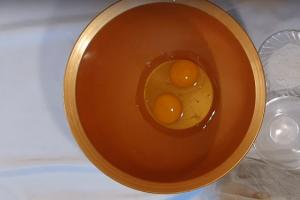Previously, I kept the soldering iron on a stand, which, frankly, was a shame to even show. Although it served faithfully for many years, the constant dangling wires various options knots, I was finally upset. It was decided to build a convenient box for carrying and storing the soldering iron.
Its design is simple. The body is assembled from scraps adjusted to the required size. The frames are screwed together, after which the pressed cardboard bottoms are nailed with a stapler.
To store the soldering iron, four bars are cut into a house, which will close when closed, thereby preventing the soldering iron from hanging around the box idle. They are fixed with a stapler.
There is also a jar of Soviet film, where I poured rosin.

When laying the soldering iron, the wire is tied with a Velcro fastener. Very convenient by the way. Nowadays, almost all wires at home have such a fastener.



The halves are connected by loops and closed with a lock. The handle is made of a cotton belt threaded through... I don’t even know what they are called :), let there be half rings taken from a discarded woman’s bag. The belt is tightened with the same staples.
In the future it is planned to add a kind of “third hand” to it.

In the end it turned out very convenient drawer: nothing dangles, nothing gets tangled, and everything is stored conveniently. True, the new powerful soldering iron began to set fire to the wood of the stands, but I will eliminate this with metal pads.
The topic of stands for soldering irons is covered quite well on our website. How is my stand different from others? — I tried to make it as compact, convenient and functional as possible. Do you want the same? - Please, cut to the chase!
The main feature of this stand is the built-in regulator. It was inconvenient because it constantly got lost and mixed up with another small pile on the table. This one is tightly screwed to the stand, it will never get lost and will not jump around the table.
The new one is better than the old one in that it has smooth adjustment and operation indication. Here is the diagram according to which I assembled the regulator:

Diode bridge - any one that can withstand the mains voltage and the current consumed by the soldering iron. (formula for calculating current - Soldering iron power / Mains voltage) A suitable diode assembly or bridge can be removed from the input circuit of the computer power supply. Instead of a diode bridge, you can use a diode, then the adjustment range will be from 50 to 100%.
It is advisable to install fuse F1, but not necessary.
Switch S1, S2 - Bipolar toggle switch with middle position. In the middle position, the soldering iron is turned off and the HL1 LED will not light up. In the position indicated in the diagram, the power of the soldering iron is regulated by trimming resistor R3; in the opposite position of the toggle switch, the current flows directly to the load, bypassing the regulator.
I made all these changes personally for myself, and it is not necessary to repeat this scheme exactly. Eat , suitable scheme you can get it from there.
Regulator board:

To cover the insides of the regulator from external influences, I made a plastic body and bent the edges using a technical hair dryer:

WITH electronic stuffing We figured out the regulator, now we move on to creating the components of the stand itself.
In order not to lose various small things and store solders, I made a small box of tin, the corners of which for strength:

The soldering iron support itself is, in my opinion, the most successful design. In order for the soldering iron to hold well in such a stop, when inserting it, its center line must be below the horns of the stop.

When soldering, a device is often necessary, but there is no need to always clutter the table with such devices - just attach an alligator clip to the stand, which is secured with a screw:

To clean the soldering iron tip, I use a metal dishwashing sponge, which will be placed in a box with edges made for it:

Stand base - Rectangular chipboard:

Milled recess for rosin:

I crushed rosin from a jar into the recess and heated it with a hair dryer so that it wouldn’t spill out:

We begin to attach the above nodes to the base; further comment is unnecessary:






The fastening of the main nodes is completed.
To prevent the stand from rolling on the table, reverse side glued rubber circles:

Well, to ensure that everything is in accordance with Feng Shui, we glue identification badges onto the regulator body:

A soldering iron stand is an indispensable attribute of a soldering installation. It can be purchased at any hardware store or on the market. However, its cost is quite high. To save your own money, a stand is made for financial issue, its functionality is considered. That is, it can be used for various needs on the farm or in a production workshop. There are quite a lot of manufacturing options. All of them differ in the complexity of the design and the amount of time spent.
General information
As mentioned earlier, a do-it-yourself soldering iron stand - convenient device, which performs many functions. First of all, it is a protective surface, which prevents damage to property.
Before working with the soldering machine, it must be warmed up. In this case, the metal case heats up to high temperatures.
Soldering iron stand - what is it for?
A high-quality part is necessary for those people who do a lot of work with soldering. To make such a device as a soldering iron stand, no special skills or abilities are required. The process uses simple and available materials and tools. Finished device easy to use. Homemade stand for a soldering iron should consist of individual elements. First of all, special containers are provided for rosin, flux and a department for mixing them. Some models are equipped with a box where small parts are stored. The soldering iron stand is suitable for any device, regardless of its power and degree of heating. When making the structure, the location of these containers should be taken into account. Everything should be located so that it is convenient for the master to solder.
How to make a soldering iron stand?
It is not profitable to buy ready-made stands, since they are expensive and small. dimensions, which are not suitable for all types of devices. Therefore, many users ask this question: “How to make a soldering iron stand with your own hands?”

Before starting production, you need to prepare the materials. To do this, you should purchase the following components:
- duralumin sheets, the thickness of which is 1.5-2 mm;
- small wooden beam ok (you can use different kinds tree);
- varnish containers;
- two metal boxes.
Once all these parts have been purchased, you can begin making the stand.

So, several holes need to be made in the plate. Containers for rosin and alcohol will be attached to them. Installation of cans is easy. The containers should be easily inserted into the structure and fit snugly against each other. After these procedures, it is necessary to make a support. It is made by bending the base.
If necessary, each person can make special racks that lift the structure a certain distance. This is done for convenience during the work process. Preparatory work ends with processing the duralumin sheet with a file or sandpaper. Corners should not have sharp ends.
Assembly of the structure
So, let's start assembling the soldering iron stand. The prepared support must be secured to a wooden beam.

This can be done using screws. Next, the prepared small containers are attached. They are attached to the base using special glue or epoxy resin. Many craftsmen also install a small container between the racks. You can store small parts in it that you will need during your work.
From wire
A stand for a soldering iron made of wire has gained great popularity among many craftsmen and amateurs. It can be made from an ordinary tin can. In the process of assembling the installation, simple parts are used:
- tin;
- pencil large diameter;
- washers and bolts;
- wire.
First you need to make a spring. The first thing you need to do is purchase wire from the store. Some people remove it from other indoor fixtures. It must be thick enough so that a soldering iron heated to high temperatures does not destroy it. In addition, only high-strength material will be used. Ready product should spring back.
Cut the required length of wire and carefully align it. To create a spring, use a large diameter pencil. Holding the wire, carefully wind it onto the pencil. The result should be a tight spiral. At its end is done special mount in the form of an ear. For these purposes, pliers are used.
The next step is to prepare the tin can. A small hole is drilled in its bottom.

This can be done using a nail or drill. Next, the stand for the soldering iron is assembled. The prepared spring is inserted into the jar and the structure is secured using a bolt and nut. To ensure a more durable fastening, washers are used. This method is quite simple. Anyone can make a soldering iron stand. Its manufacture does not require much time or special tools.
Soldering iron stand with power regulator
All more people prefer to use this particular type of stand. Its essence lies in the fact that it is equipped special device, which independently adjusts the degree of heating of the soldering iron. Therefore, the device does not overheat and does not fail. The stand differs from other types in that it requires an electrical connection to function. To make a version with a power regulator, you need to take the following elements:
- copper wire;
- a small piece of plywood;
- transformer;
- LEDs;
- fastening parts;
- resistor;
- wires;
- socket for connecting to the network.
After everything necessary details were purchased, proceed directly to assembling the stand.

First, select the size of the installation. Based on this information, a base is cut out of a sheet of plywood. Next, the transformer and other parts will be attached to it.
Fuse stand
Manufacturing this option does not take much time, effort, and also does not require large financial investments. The base is a wooden beam onto which the fuse jaws are attached. They can be of different sizes. It all depends on the personal preferences of the masters.
Benefits of stands
First of all, the main advantage is mobility. Homemade stands are used by people who quite often do soldering, working within several workshops. Such a design is not always at hand. However, it is easy to make. In addition, there is no need to carry rosin and tin separately in different containers, since now they are stored in special jars on a stand. That's why homemade installations They are popular not only among amateurs, but also among professionals.
How to make a simple model?
It happens that you urgently need to use a soldering iron, but there is no stand for it.

In this case, there is no time to look for the necessary parts and run around the shops. Therefore, it is better to make a simple one, but also reliable design. There are many options, but there is the fastest one. The stand can be made in a few minutes. The base will be the usual wooden block, and stands - screws or nails. They are driven crosswise into the beam. This creates a stand on which the soldering iron fits well and holds tightly.
Conclusion
When soldering elements, there must be a stand for the device. This auxiliary equipment is expensive, so it is better to make it yourself. This process will not take much time, effort, and will also save money.
The main tool for a home radio amateur is a soldering iron. Unlike other devices, it cannot simply be placed on a table (workbench) while working. Why? Right! He is hot. Therefore, you will need a special stand.
There are a lot of different devices on sale, from a simple holder to a whole complex called a soldering station.
In most cases, a soldering iron is needed to perform urgent tasks. repair work. If you are not a professional “homemade” tool, the instrument usually gathers dust in a box on the balcony, appearing once or twice a year. In such cases, many people use the first object they come across as a stand.

However, if you put in just a little effort, a DIY soldering iron stand will look no worse than a factory one. Especially if you regularly make electrical circuits.

Minimum required for stand
- Stable base. Made from a material that conducts heat poorly or equipped with legs
- Soldering iron supports
- Container for rosin (flux).
Additional options"
- Tinning area
- Solder container
- Tip cleaning device
- power regulator (can be of two types: smooth adjustment, or stepwise limitation for the time of a break in work).
Leafing through old magazines
In old Radio magazines you can find drawings on how to make a stand with an economical load switch.

- As a basis ( 1 ) a board with a selected middle is used, or a U-shaped structure made of a strip of plywood and two bars along the long edges
- Under the surface there is a 220 volt relay contact group ( 2,4,5 ) with large current collecting areas. The connection circuit transfers power either directly or through a diode. The radio element “cuts off” halves of the half-cycle AC voltage 220 volts, reducing it to 110
- Through traction ( 6 ), spring loaded ( 7 ) button ( 8 ) presses the contacts when the soldering iron is lying on the stand. Electricity consumption is half as much, while the soldering iron almost instantly heats up to full power. The rod is attached to the console ( 9 )
- The tool itself is located on brackets ( 3 ) And ( 10 )
- At the rear there is a soldering iron socket connected to the relay output contacts. The power supply wire is connected to the input
- Between the posts, a tin can of shoe polish or Vaseline was usually nailed for storing rosin.
Every radio amateur or just a beginner in this business knows how to work with a soldering iron, and for its convenient use a stand is needed. In this article I will talk about how to make a homemade budget stand for a soldering iron.
In order to assemble our stand you will need:
* Chipboard sheet, 18 mm thick, could be thicker, but I think this is the most optimal thickness.
* 4 self-tapping screws 20 mm and 4 smaller bolts.
* Sandpaper coarse-grained.
* A couple of rubber stoppers from chemical test tubes.
* Hacksaw for metal.
* Phillips screwdriver or screwdriver.
* A thin screwdriver, an awl will also work.
* Pliers.
* Iron plate.
* Metal mount from the antenna.
* A tin from an old receiver that covers the board.
* Spring from a fountain pen.
* The soldering iron itself is for testing.
The first step will be to sand the already cut chipboard sheet. We sand thoroughly and give the edges a rounded appearance. We bring the blank for the stand to this form. The photo shows which workpiece was before grinding and which after.






Having thought that many purchased stands are so simple that they do not have legs, I decided to make rubber feet for my stand.

We saw through the rubber plugs taken from the chemical test tubes with a hacksaw, making them the same thickness using sandpaper if it was not possible to saw off smoothly.


After that, screw a 20 mm self-tapping screw into each leg.

And screw the leg with a screw into the pre-prepared hole.

Screw on the first leg.
We fasten the second, third and fourth in the same way. We've sorted out the legs, now the stand won't go anywhere and won't scratch the table.





The next thing I did was bend the iron plate into a hook shape, as in the photo.



Using a screwdriver to small parts I made a hole for two bolts that will hold this hook.


We tighten the bolts, as we can see the hook holds well.



Let's try on how the soldering iron will sit.

Using pliers, bend one edge of the hook, it should look something like this.

So, the heating part of the soldering iron is not going anywhere now, so let’s move on to the back of the soldering iron, or rather to the handle.
I decided to make this holder from an antenna mount that had been lying around for a long time; there are already holes there.

There is also a recess where the soldering iron handle fits well.


We fasten this mount with two screws.


And now the soldering place, since the tin needs to be taken from somewhere, for convenience we will make it closer to the soldering iron tip.
I punched a hole in the record that I took out of the radio and screwed a bolt into it; it firmly pressed it to the stand.




From ballpoint pen, which had just ended, I removed the spring and decided to put it on our hook, first I bent one end of it, then I made a hole with a screwdriver in the board of the stand and inserted this end of the spring there, and soldered it to the hook at the top.




The stand is almost ready, the next thing I did was melt the tin at the soldering site, now, if necessary, I can heat this place and tin the wires there.








